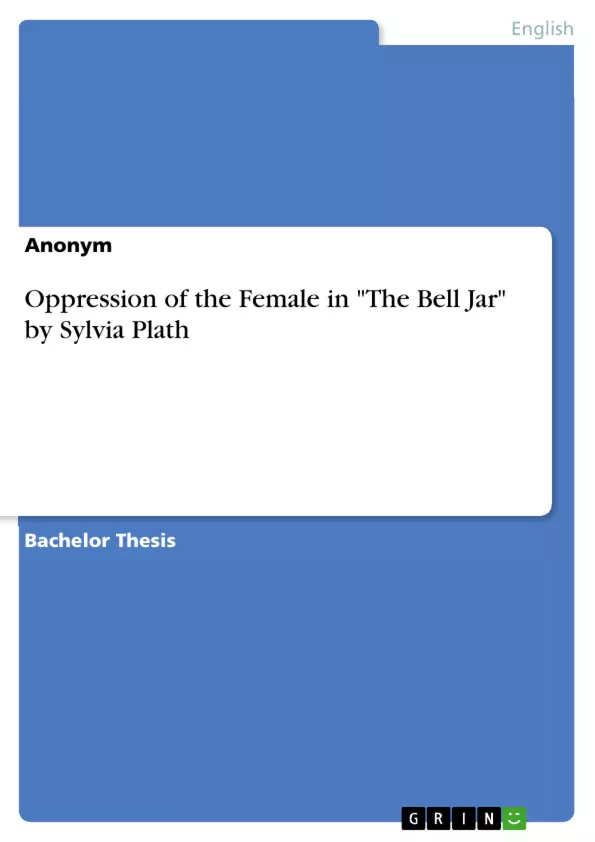The purpose of this thesis is to examine how female authors have presented their own views of a gender restrictive era.
Therefore, I am going to analyze two feminist theories, Margaret Fuller's theory "Woman in the nineteenth century" (1845) and Betty Friedan's "Feminine Mystique" (1963), as well as Sylvia Plath's novel "The Bell Jar" (1963). These texts are chosen as they all deal with issues related to femininity and tried to redefine gender roles at their time.
The first part of this thesis will compare the theoretical ideas of Friedan and Fuller in order to see how these authors have experienced the patriarchal system of their time and to what extent the role of women in American society has changed. Both theories are important for the analysis of "The Bell Jar" as they contribute to an understanding of the protagonist's struggle to adapt to the implicit rules of the patriarchal system she lives in.
The concepts of marriage, education and career as well as motherhood and domesticity are exclusively chosen to explain Esther's place in a society that has certain expectations and rules for women the heroine can no longer accept. Sylvia Plath's novel calls attention to the injustice of the treatment young women received at that time and shows the destructive effects of her era on women who refused to conform to ideals and rules made by the patriarchal system.
The main part of this thesis examines how the novel presents the oppressive system of 1950's America in which the heroine has to live in. With "The Bell Jar", Plath provides insight into 1950's America and underlines several issues regarding femininity. She demonstrates these issues with several characters that are either challenging or upholding the system, with character relationships or with medical institutions that "stand as an emblem for women's oppression". Thus, the focus will be on analyzing the instruments and devices Plath uses to shed light on the inequality women experienced at that time.
Inhaltsverzeichnis (Table of Contents)
- Introduction
- Feminist Theories
- Comparison Marriage
- Comparison Education/ Career
- Comparison Domesticity/ Motherhood
- The Bell Jar
- Role models
- Fake Identities
- Relation to Men and Sexuality
- Motherhood
- The Symbol of the Fig-Tree
- Apparent opportunities for women in the 1950's
- Conclusion
Zielsetzung und Themenschwerpunkte (Objectives and Key Themes)
This thesis aims to investigate how female authors presented their perspectives on a gender-restrictive era by analyzing two feminist theories and Sylvia Plath's novel, *The Bell Jar*. The primary focus is to explore how these works address issues of femininity and redefine gender roles within their respective historical contexts.
- Oppression of women in a patriarchal system
- The impact of social expectations and limitations on women's lives
- The struggle to achieve personal identity and fulfillment in a restrictive society
- The changing role of women in society and the challenges they face
- The symbolism and imagery used to depict female experiences and societal pressures
Zusammenfassung der Kapitel (Chapter Summaries)
- Introduction: This chapter provides a general overview of the thesis's objectives, focusing on the importance of feminist literature in challenging established ideals of femininity. It introduces the two feminist theories and Sylvia Plath's novel that will be analyzed throughout the thesis.
- Feminist Theories: This chapter compares Margaret Fuller's *Woman in the Nineteenth Century* and Betty Friedan's *The Feminine Mystique*, examining how their descriptions of oppression differ or evolve across time. It highlights the key concepts that will be used to understand the situation of Sylvia Plath's protagonist.
- Comparison Marriage: This chapter explores how both Fuller and Friedan viewed marriage as a restrictive institution that limited women's freedom and autonomy. It analyzes their criticisms of traditional marriage practices and their visions of a more equitable partnership.
- The Bell Jar: This chapter delves into Sylvia Plath's novel, introducing the main characters and their relationships. It focuses on how Plath uses her characters, their interactions, and medical institutions to illustrate the oppressive system of 1950s America.
- The Symbol of the Fig-Tree: This chapter examines the significance of the fig-tree symbol in *The Bell Jar* and how it relates to the opportunities and challenges faced by women in the 1950s.
Schlüsselwörter (Keywords)
This thesis examines feminist literature, focusing on themes of gender roles, societal expectations, female oppression, and personal identity. Key terms include feminism, patriarchy, restrictive society, femininity, identity crisis, marriage, education, career, motherhood, domesticity, and the symbolism of the fig-tree.
- Quote paper
- Anonym (Author), 2019, Oppression of the Female in "The Bell Jar" by Sylvia Plath, Munich, GRIN Verlag, https://www.grin.com/document/538619



